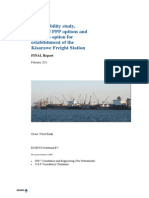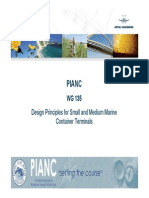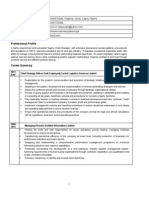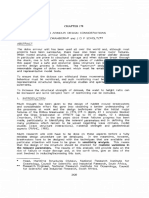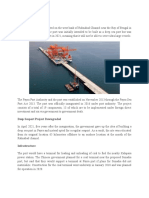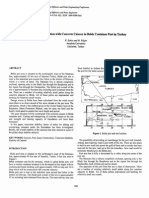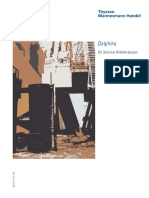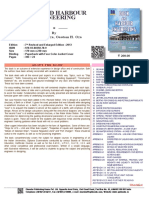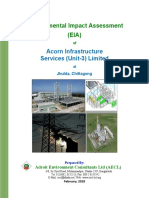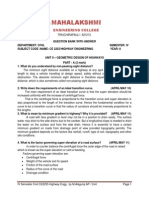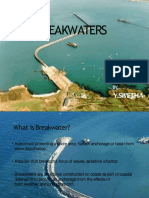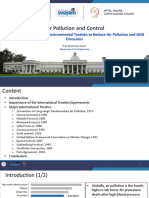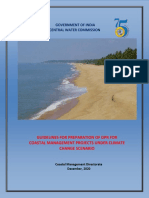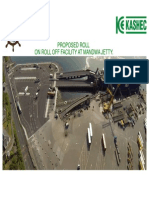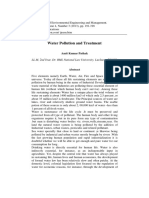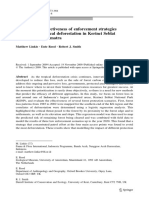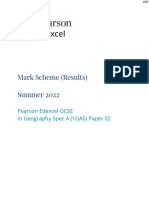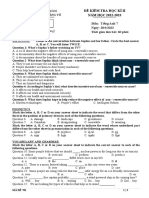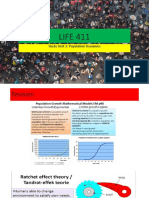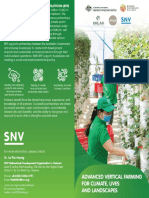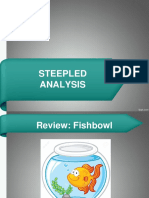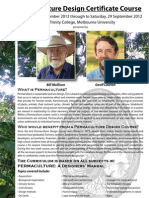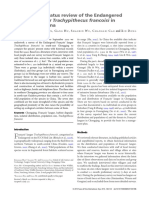EA TOR For Ports Harbours
EA TOR For Ports Harbours
Uploaded by
Herum ManaluCopyright:
Available Formats
EA TOR For Ports Harbours
EA TOR For Ports Harbours
Uploaded by
Herum ManaluOriginal Description:
Original Title
Copyright
Available Formats
Share this document
Did you find this document useful?
Is this content inappropriate?
Copyright:
Available Formats
EA TOR For Ports Harbours
EA TOR For Ports Harbours
Uploaded by
Herum ManaluCopyright:
Available Formats
[This sample Terms of Reference for EIA is intended to be used by Project
Officers involved in the preparation of feasibility studies for port projects.
The sample TOR has been written in a detailed and comprehensive
manner, and Project Officers are advised to remove material that is not
relevant to their particular project.]
Terms of Reference for Environmental Impact
Assessment of Ports and Harbours
1.0. Background
Over the last three decades, environmental impact assessment (EIA) or
environmental assessment (EA) has become a major tool for effective
environmental management. Over the years, the focus of EIA changed
towards making it a useful tool for environmental sustainability, which can
be very effectively put to use to ensure that all important factors are
included and unnecessary factors are revealed and dropped. This
contributes towards ensuring that the environmental sinks and resources
are not so excessively stressed as to cause any reduction in the
assimilative capacity.
2.0. Need for Environmental Assessment (EA)
Development of port and harbour facilities can make a significant
contribution to the economic development and growth of maritime
transport. At the same time, it may also create adverse impacts on the
surrounding environment. Port development may create a wide range of
impacts on the environment through activities such as construction work,
dredging, reclamation of the required land, landfills, discharges from ships
and cargo operations, and other port related activities.
Port development and operation should, therefore, be planned with careful
consideration of the environmental impacts. Thus, the preparation of an
EIA report and implementation of EMP is essential for effectively managing
these adverse effects.
In view of the above issues, the EA is carried out with the following
objectives:
Establishing the environmental baseline in the study area and
identifying any significant environmental issue
Assessing these impacts and provide for the requisite avoidance,
mitigation and compensation measures
Integrating the identified environmental issues in the project
planning and design
Developing appropriate management plans for implementing,
monitoring and reporting of the environmental mitigation and
enhancement measures suggested
The EA studies and reporting requirements to be undertaken under these
ToR must conform to the Government of India (GoI) and World Bank
guidelines and regulations, which include, inter alia, the EIA amendments
and updated guidelines.
The EA comprises following stages: Environmental Screening,
Project EA and the Environmental Management Plan (EMP)
3.0. Project Description
This section should cover the broader details of the basic activities, such
as
Location, layout and implementation schedule of the project
Type of the projectnew, expansion, modernization, container
cargo-handling facility, fishing, minor/major port, etc.
Relevance of the project in light of the existing development
plans of the region
Project coverage, master plan, phasing and scope
Description of a project site, geology, topography, transport and
connectivity, demographic aspects, socio-cultural and economic
aspects, villages and settlements
Capacity of the port, types of cargo proposed for handling, cargohandling equipments, ancillary operations, housing, truck-parking
details, etc.
Technologies involved in design, construction, equipment and
operation
Use of existing public infrastructureroad, railway and inland
waterway networks, water supply, electrical power, etc.
Estimated water balance for the proposed project during
construction/operation stages
Estimated cost of development of the project, environmental
cost, funding agencies, and whether the project is being
implemented through government/international funding or on the
basis of BOT
Details of land acquisition, rehabilitation of communities/villages
and present status of such activities
Resources, manpower and time frame required for project
implementation
3.1. Essential Maps to be Provided with the Project Description
A map specifying locations of the state, district and project
A map of project and the area within 10km of the boundary of the
proposed/existing project area, delineating (i) protected areas
notified under the Wildlife (Protection) Act, 1972, (ii) critically
polluted areas as notified by the CPCB from time to time, (iii)
notified eco-sensitive areas, and (iv) inter-state and international
boundaries
A map covering aerial distance of 15km on the landward side
from the proposed project boundary, delineating environmentally
sensitive areas as specified in column 9(iii), Form I of EIA
notification dated Sept. 14, 2006
Land-use map of the study area on a 1: 25,000 scale based on
recent satellite imagery of the project and the area within 10km
of the proposed project boundary, delineating the cropping
pattern, wastelands, forest area and built-up areas, water bodies,
human habitation and other surface features such as railway
tracks, ports, airports, roads, national highways and major
industries
Site layout plan of the proposed development shall be submitted
on a scale of 1:5000, clearly marking the layout of breakwaters,
navigation channels, harbour basin, berths, dry docks,
workshops, container freight station, cargo handling systems,
conveyors, covered and uncovered storage yards, warehouses,
roads, railway tracks, effluent disposal points, administrative and
operational buildings, utilities, townships, green belts, dredged
material disposal, etc. Boundaries of the proposed port shall be
shown therein with latitude and longitude.
Area drainage contour map of the project and area within 2-5km
of the proposed project area
Any proposed diversion of drain/canal/river
Hydrographic charts of the offshore area giving general
morphology of the coastal stretch on a scale of 1:50,000 covering
water depth up to 10m beyond the maximum proposed dredging
depths of the project and covering a distance of 5km along the
coast from the project limits on both sides
The Costal Regulation Zone (CRZ) maps indicating the high tide
level (HTL) low tide level (LTL), demarcated by one of the seven
authorized agencies and the project layout superimposed on the
map submitted on a 1:5000 scale map, which is reviewed and
recommended by the Coastal Zone Management Authority
(CZMA) of the state/union territory
4.0. Stage I. Environmental Screening (ES)
This is done in the early stages of the project preparation to:
Make a preliminary assessment/review of the environment issues
that are relevant to the proposed project thus making it
environmentally sound and sustainable
Determine the extent and type of project EA to undertake
Recommend possible modifications in the preliminary project
design
Scope of Work for ES
The general approach to be adopted for ES includes:
Brief description of the project as mentioned in section 3.0.
Preliminary reconnaissance surveys to identify baseline
conditions and environmentally sensitive issues relating to the
project site and influence area and baseline conditions, including
regionally and nationally recognized environmental resources and
features, such as national parks, wildlife sanctuaries, game
reserves, tiger reserves/elephant reserves/turtle nesting grounds,
breeding grounds, core zone of biosphere reserve, habitat for
migratory birds, mangrove area, areas with threatened (rare,
vulnerable, endangered) flora/fauna, protected corals, wetlands,
zoological gardens, gene banks, reserved forests, protected
forests, any other closed/protected area under the Wildlife
(Protection) Act, 1972 and any other area locally applicable
Assessment the potential impacts of the project on the baseline
conditions
Recommended mitigatory measures to offset the identified
adverse impacts
Stakeholder assessment and consultations
Identification of the Valued Environmental Components (VECs)
considering the baseline information (collected from both
secondary and primary sources), the preliminary understanding
of the activities proposed in the project and from stakeholder
consultations
Preliminary analysis of impacts identified in the project site and
surroundings
and
the
formulation
of
management
measures/options
Preparation of scoping for project EA, which will be a direct
outcome from the above-mentioned ES, and shall define
boundaries of the project EA and include what is covered in the
project EA
Documentation of the above-mentioned ES in the form of
Environmental Screening Report
This report can form a part of the Detailed Project Report (DPR)
or Technical Feasibility Report
5.0. Stage II. Project EA
Detailed assessments are done at this stage. It includes carrying out the
detailed EA or EIA and preparing reports like EA Report, leading to
development of Environment Management Plans (EMPs).
The Scope of Work for the Project EA
This shall include the following:
5.1. Detailed description of the project as mentioned above (information
collected from the engineering and design section of the project and from
the
technical
feasibility
report),
along
with
required
maps/designs/documents
5.2. Discussion of the policy, legal and administrative framework within
which the project is set, major stakeholder departments of the state and
central government with their specific roles, applicable laws and clearance
requirements at various levels and their current status
5.3. Analysis of Alternatives (Technology & Sites)
In case, the scoping exercise indicates a need for alternatives, this chapter
shall include:
Description of various alternatives like locations or layouts or
technologies studied
Description of each alternative
Summary of adverse impacts of each alternative
Selection of alternative
5.4. Stakeholder consultations, which will include community consultations
at the state, district, village and roadside community levels, to improve
project components with regard to proper environmental management
5.5. Description of the Environment
Baseline surveys generally include:
a) Collection of information from secondary sources that are necessary
for understanding the baseline pertaining to physical, biological and
socio-economic environments project and influence area
b) Carrying out site visits and investigations of all the environmentally
sensitive locations and document them on the base maps to identify
conflict points with preliminary design
c) Preparing detailed specific maps showing details of sites for
environmental enhancements. These surveys are to be carried out
as per the standards prescribed by Government of India, which if not
available, shall conform to international practice
It is recommended that the environmental surveys be co-ordinated with
social and engineering surveys and done simultaneously, as far as
possible.
5.5.1. Study Area
As a primary requirement of EIA process, the proponent should collect
primary baseline data in the project area as well as in the area within 5km
of the proposed project boundary. Secondary data should be collected for
area within 15km aerial distance from the project boundary, as specifically
mentioned in column 9(iii) of Form I of EIA Notification 2006. This should
be depicted on a map.
Following components of the environment shall be studied.
5.5.2. Land Environment
(a) Land
Availability of land for earmarking for the port without causing undue
hardship to local habitat and their socio-cultural and economic aspects is
very important. Data on the land availability is to be ascertained from
local authorities, revenue records, etc. Justification for the proposed
quantum of the area is to be given.
(b) Topography
Baseline data needs to be given on existing situation of the land at the
proposed project area including description of terrain hill slopes coastal
and inland topography, coastal features (lowland, beaches, littoral areas
and shoal areas), terrain features, slope and elevation. Study of land use
pattern, habitation, cropping pattern, forest cover, environmentally
sensitive places, etc. should be made by using remote-sensing techniques
(if available) and secondary data sources.
(c) Geology
Baseline data should be provided on rock types, regional tectonic setting
(reported fractures/faulting, folding, warping), and history of any volcanic
activity, seismicity and associated hazards, mainly in the coastal area.
Information on quarry yields, strength of rock, distance of quarries from
habitat, restrictions for quarrying, environmental controls, statutory
permissions, etc. should be provided.
(d) Soil
Soil data, including type, classification, characteristics, and soil properties
are important engineering considerations for design of structures, loading
capacities of cargo stockpiles, green belt development, etc. Changes in
parameters of soil also may affect plantation and vegetative growth,
which in turn may endanger the health of local habitat. Baseline data of
the soil and results of investigations carried out are to be provided for the
project area.
(e) Meteorological Data
Meteorological data covering the following should be incorporated in the
EIA report.
Data for at least a 10-year period should be presented from the nearest
meteorological station. The history of cyclones and tidal surges for the
area shall be mentioned. The data pertaining to the following parameters
shall be included:
Wind speed and direction
Rainfall
Relative humidity
Temperature
Barometric pressures
History of cyclones
5.5.3. Water Environment
(a) Groundwater
Baseline data on groundwater including data on pH, dissolved solids,
suspended solids, BOD, DO, coli-form bacteria, oil and heavy metals
(depending upon the type of cargo) is to be collected at least for one
season. Usage purpose of the groundwater, if any, is to be indicated.
(b) Surface Water
Baseline data on location of surface water like lagoons, lakes, tidal inlets,
streams, rivers and their details such as their present quality and utility, if
any, is to be provided. Details of water bodies in the project area shall be
described specifically. Water quality is to be monitored for one season (3
months) other than monsoon season.
5.5.4. Marine Environment
(a) Coastal hydrology/geomorphology
Coastal hydrology requires collection of oceanographic data during the
study period, covering the following parameters:
Tides
Waves (wind waves and swells)
Storm surges
Currents
Salinity
Sea water temperature
Suspended load
Seabed bathymetry
Baseline oceanographic data should extend at least to depths more than
10m of proposed deepening of the harbour approach and basin as per the
master plan proposed. A study on likely changes in the sediment transport
and littoral drift due to the construction of port, particularly the
breakwater, should to be taken up.
Details of mangroves, marshes and other coastal vegetation, sand dunes,
coastal stability, seismic characteristics, history of any endangered
species, coastal erosion and shoreline changes should be furnished.
(b) Bed sediment contamination
Baseline data on bottom sediments and the associated bottom biota and
other physical habitat at the proposed project area and the neighbourhood
areas should be collected and analyzed.
(c) Sea/Harbour water quality
Baseline data shall be collected on chemical parameters in the open sea
and in the proposed port area for understanding hydrochemical
characteristics in the marine environment (such as sea water
temperature, BOD, DO, pH, TSS, salinity, heavy metals depending on the
cargo, etc.)
5.5.5. Biological Environment
(a) Marine/Coastal ecology
Baseline data on aquatic flora and fauna, mangroves, marshes and other
coastal vegetation, sand dunes at the project area, including the coastal
area, is to be ascertained through proper surveys. Data on coastal
stability, seismic characteristics, history of any endangered species,
coastal erosion, shoreline changes, if any, is also necessary.
(b) Terrestrial ecology
Details on secondary data on the existing flora and fauna in the study
area as well as that within 15km of its boundary, carried out by an
university/institution under the relevant discipline (such as Botanical
Survey of India, Zoological Survey of India, Wildlife Institute of India, etc.)
shall be included in the list of flora and fauna along with the classification
as per the schedule given in the Wildlife Protection Act, 1972 (for fauna)
and in the Red Book Data (for flora). Also, a statement clearly specifying
whether the study area forms a part of an ecologically sensitive area or
migratory corridor of any endangered fauna should be provided.
5.5.6. Air Environment
Baseline data of ambient air parameters, such as RSPM, nitrogen dioxide,
sulphur dioxide, carbon monoxide, heavy metals and other harmful air
pollutants, depending upon the type of the cargo, should be monitored.
This data should be collected in an area extending at least 5km from the
project boundary by observation at a number of locations. Specific
importance should be attached to areas in close proximity to the project,
say up to 1km. Data for one season, other than monsoon, should be
monitored as per the CPCB Norms. The control station should be in the upwind/non-impact/non-polluting area.
5.5.7. Noise
Baseline data on noise pollution at the project area and the
neighbourhood up to a specified distance or nearest residential areas is to
be monitored as per the CPCB norms.
5.5.8. Existing Solid Waste Disposal facilities
Details of authorized municipal solid waste facilities, biomedical treatment
facilities and hazardous waste disposal facilities in the area should be
inventoried if they will be utilized.
5.5.9. Socio-economic and Occupational Health Environments
Baseline data at the project area shall include the demography,
particularly on human settlements, health status of the communities,
existing infrastructure facilities in the proposed area and area of impact
due to the proposed activity. Present employment and livelihood of these
populations and awareness of the population about the proposed activity
shall also be included.
5.5.10. Public Utilities
Baseline data of existing public utility infrastructure shall be ascertained
and reported to assess the impacts of the project on these public utilities
in order to incorporate desired methods in the EMP and the same shall be
monitored during the construction as well as operational phases of the
port.
6.0. Anticipated Environmental Impacts and Mitigation Measures
This section should describe the likely impact of the project on each of the
environmental parameters and the methods adopted for assessing the
impact such as model studies, empirical methods, reference to existing
similar situations, reference to previous studies, details of mitigation
methods proposed to reduce adverse effects of the project, best
environmental practices and conservation of natural resources. The
identification of specific impacts followed with mitigation measures should
be done for different stages i.e., location of the port, construction
including dredging, ship traffic including discharges from vessels and
cargo operations.
6.1. Land Environment
Anticipated Impacts:
Impact of project construction/operation on the land requirement/land-use
pattern should be assessed. Effect of future growth of the port facility
and/or the ancillaries should be carefully assessed by preparing master
plans for the port and the ancillaries. Impact on the public utilities arising
out of the utilities for the project activities and the impact on the natural
drainage system are equally important. Prediction of impacts should
include impacts on the existing infrastructures like road network, housing ,
groundwater/surface water, loss of productive soil and impact on natural
drainage pattern.
6.1.1. Mitigation Measures:
soil
improvement techniques and suitable design methods to reduce land
requirement. Where land acquisition and consequential R&R methods are
required, they should be implemented duly adhering to the norms and
complying with pertinent statutory requirements for such land acquisition.
Strengthening of road and rail network infrastructure to handle the
increase in traffic and truck parking arrangements and integration of Port
development with the local land-use plan should be planned.
Mitigation
measures
to
reduce
adverse
effects
include
adopting
6.1.2. Topography, Geology and Soil
Anticipated Impacts:
Impact of port construction/operation on the topography due to large
scale quarrying, filling of low lying area with dredged spoil and borrowed
material, damage to existing vegetation/green belt and plantation,
changes in land-use patterns, disturbance to existing protected areas like
mangroves, forests and environmentally sensitive areas/zones should be
assessed. Flooding due to filling up of low-lying areas should also be
assessed. Impacts on the surrounding land-use pattern, housing,
groundwater, etc. should be assessed.
Impact of the project construction on the geology and vice-versa should to
be studied in detail. Impact of project construction/operation on the soil
parameters, probability of settlement, subsidence, slides, surface
drainage, leachates, etc. are to be estimated
Mitigation Measures:
Mitigation measures to reduce adverse effects include study of alternative
sites, improving green belt, obtaining construction materials from other
sources, usage of alternative construction materials like fly ash, where
possible, and storm water management. Other measures include adopting
soil improvement techniques, suitable design methods and ground
covering.
6.2. Water Environment
6.2.1. Groundwater
Anticipated impacts:
Discharge of trade effluent and sewage and its impact should be studied.
Impact of project construction/operation on the groundwater on account of
leachates, run off from material and cargo storages, and toxic or harmful
substances, percolation, sea water intrusion should also be assessed.
Mitigation measures:
Mitigation measures to reduce adverse effects include constructing cargo
areas with impervious paving, impervious roads, lined drains, routing
surface drainage to settlement tanks/pits etc. Treatment of effluent,
recycling/reuse and disposal should be planned. Groundwater study on
leachates should be carried out periodically and should be correlated with
baseline data. Remedial measures should be taken in case of any
deviation. Based on the total water budget of the project, the use of
groundwater should to be reviewed and alternatives should be presented.
6.2.2. Surface Water
Anticipated Impacts:
Impact of port operations on surface water sources, contamination due to
cargo operations, impact on utility of surface water resources by the
neighbouring colonies, impact on surface water flow (e.g. flooding) due to
anticipated obstructions, etc. should be assessed.
Mitigation measures:
Measures should be taken to protect surface water resources and prevent
reduction in their quality due to construction and operational activities
and choice of alternative resources. Proposals to treat effluents confirming
to standards notified under EP Act 1996 should be submitted.
6.3. Marine Environment
6.3.1. Coastal Hydrology
Anticipated impacts:
Impact of the project construction/operation on the coastal hydrology on
account of port construction should be assessed by using suitable model
studies.
Mitigation measures:
Careful site selection and port design should be planned to minimize
impacts due to changes in current patterns and other coastal hydrology.
Model experiments or computer simulations of these changes are useful in
developing an appropriate design. Shore protection works like
construction of sea walls, groynes, sand bypassing or beach nourishment
should be studied.
6.3.2. Bed Sediment Contamination
Anticipated impacts:
Impact of the project construction/operation on the bed sediment
contamination on account of port construction/operations is to be
assessed by using suitable empirical/model studies.
Mitigation measures:
A survey of the contamination of bottom sediments should be undertaken
before dredging.
6.3.3. Sea/Harbour Water Quality
Anticipated impacts:
Impact of the project construction/operation on the sea/harbour water
quality on account of port construction is to be assessed by using suitable
empirical/model studies.
Mitigation measures:
Proper collection and disposal of liquid and solid waste from shore
establishment and ships should be planned.
6.4. Biological Environment
Anticipated impacts:
Impacts of the project construction/operation on the marine/coastal
ecology on account of port construction should be assessed by using
suitable empirical/model studies. Impacts due to floodlights on the nesting
of sea turtles and other species should be studied.
Mitigation measures:
Mitigation measures to reduce adverse effects should be provided.
6.5. Air Environment
Anticipated Impacts:
Impact of project construction/operation on the ambient air quality on
account of emissions of dust during construction and cargo handling, as
well as emission of gases from equipment deployed for construction and
cargo handling should be assessed.
Prediction of emissions during cargo handling/emissions from the ships in
the port area/emissions due to increased traffic, emission inventory for
critical pollutants with and without mitigation measures should be done.
Further, prediction of the impact due to the existing activity on the
proposed project and the prediction of impacts due to sanctioned/on-going
projects in the surrounding area on the proposed project and the ambient
environment shall be carried out.
Mitigation measures:
Mitigation measures proposed during the construction stage should
include dust suppression measures by suitable techniques. Similarly,
mitigation measures proposed during the operation stage should include
alternative solutions, such as closed conveyor system, closed silos and
closed vehicles to transport dusty cargo. Other mitigation measures for
lowering the emissions from the ships and green belt development should
be taken.
6.6. Noise Pollution
Anticipated impacts:
Impact of project construction/operation, including noise and vibration on
account of construction equipment, cargo handling equipment and road
traffic should be assessed.
Mitigation measures:
Mitigation measures to reduce adverse effects should be provided.
6.7. Solid Waste Management
Anticipated impacts:
Impact due to non-hazardous and hazardous solid waste generated during
the construction and operational stages should be assessed.
Mitigation measures:
Mitigation measures to comply with the norms should be planned. Options
for minimization of solid waste and environmentally compactable
disposal/recycling of waste to conserve natural resources should be
planned. Plans should be made for management and disposal of
temporary structures made during the construction phase.
6.8. Socio-Economic and Occupational Health Environment
Anticipated impacts:
The impact of the proposed activity on the communities should be
predicted. Details of public and private land in the proposed and
immediate surroundings and the socio-economic status of the affected
owners of the private land shall be provided. Present status of health,
housing, public utilities, commercial structures and transportation should
be collected.
Impact of the project on socio-cultural aspects should be assessed. Socioeconomic impacts due to displacement of fishing settlements and
population influx due to increased activities should be assessed.
Mitigation measures:
Mitigation measures to reduce adverse effects including satisfactory R&R
methods should be planned.
7.0. Stage III. Environmental Management Plan (EMP)
7.1. The scope of the EMP shall include:
Design modifications recommended by the project EA, along with
chainages
Recommendation of feasible and cost-effective measures to
prevent or reduce significant negative impacts to acceptable
levels
Identification of opportunities for enhancement of environmental
quality (of specific locations, water bodies, scenic areas etc.) in
the project area
Formation of specific or sample plans, such as those for
management and redevelopment of quarries, borrow pits and
construction camps
Detailed specification of bill of quantities, execution drawings and
contracting procedures for execution of environmental mitigation
and enhancement measures suggested, separate for preconstruction, construction and operation stages
Suggestion of good practices for construction and upkeep of
plant and machinery, responsibilities for execution and
supervision of each of the mitigation and enhancement measures
identified in the project EA
Description of implementation arrangement needed for the
project, especially the capacity-building proposals
Specification of environmental supervision, monitoring and
auditing requirements, including the technical aspects of
monitoring the effectiveness of mitigation measures (including
measurement methodologies, data analysis, reporting schedules,
emergency procedures, detailed budget and procurement
schedules)
Summary
matrix
of
environmental
monitoring,
during
construction and operation stages, along with the requirement of
monitoring facilities, frequency, location, parameters of
monitoring , compilation and analysis of data, comparison with
baseline data, compliance to accepted norms and reporting
system, and plantation monitoring programme
Listing of all the mandatory government clearance conditions and
the status of procuring clearances
Inclusion of separate attachment, if applicable, Natural Habitat
Plan and /or Cultural Properties Plan to satisfy the requirements
of the World Bank safeguard policies,
8.0. Additional studies
Studies on the following need to be conducted:
Risk Analysis and Disaster Management Plan (DMP)
Safety measures for handling bulk liquid substances
Personal protection equipment
Oil-spill contingency plan
Bio-diversity studies, if and when required
Emergency response procedures, natural resource conservation
and optimization, plan of action for conservation of natural
resources
Utilization of fly ash and other suitable waste materials
Dredged material utilization and disposal plan
Detailed R&R plan with data on the existing socio-economic
status of the population in the study area and broad plan for
resettlement of the displaced population, site for the
resettlement
Issues identified by the public and other stake holders during public
hearings along with the issues raised by the public and the responses of
the project proponents should also be studied.
These additional studies can be annexed with the EMP Report.
9.0. Executive Summary (Summary EIA)
This should be a summary of the EIA report, condensed to 10 A-4 size
pages at the maximum. It should necessarily cover in brief the following
chapters of the full EIA report: Introduction, Project Description,
Description of the Environment, Anticipated Environmental Impacts &
Mitigation Measures, Additional Studies, Environmental Monitoring
Programme, Project Benefits and Environmental Management Plan (EMP)
Such an Executive Summary may be required during the public
hearing process for distribution to interested public on demand.
If required, it has to be translated into a local language.
10.0. Major Outputs from the Environment Perspective
1)
Inception Report with work plan
2)
Draft Environmental Screening Report
3)
Final Environmental Screening Report
4)
Draft Project Environmental Assessment (EA) or EIA Report
5)
Draft Environmental Management Plans (EMPs)
6)
Final EA Report
7)
Final EMPs
You might also like
- TOR WG 135 Design Principles For Container Terminals in Small and Medium Ports FinalDocument4 pagesTOR WG 135 Design Principles For Container Terminals in Small and Medium Ports FinalHerum ManaluNo ratings yet
- Bamboo Proposal PDFDocument7 pagesBamboo Proposal PDFCirilo Jr. Lagnason100% (1)
- TOR MarCom 144 Classification of Soils and Rocks For The Dredging ProcessDocument2 pagesTOR MarCom 144 Classification of Soils and Rocks For The Dredging ProcessDeanna BarrettNo ratings yet
- The Impact of Russia and Ukraine War On Environmental ConditionDocument10 pagesThe Impact of Russia and Ukraine War On Environmental ConditionPUTU DARMAWANNo ratings yet
- Method Statement For Navigation Aid C02 EditedDocument40 pagesMethod Statement For Navigation Aid C02 EditedOlugbemiga James OlalekanNo ratings yet
- Ports and Terminals - DHI BrochureDocument6 pagesPorts and Terminals - DHI BrochureClaire FloquetNo ratings yet
- Kisarawe Final ReportDocument173 pagesKisarawe Final ReportHerum ManaluNo ratings yet
- Brochure Integrated Container Terminal Planning Optimization EN PDFDocument10 pagesBrochure Integrated Container Terminal Planning Optimization EN PDFHerum ManaluNo ratings yet
- Wg135 Mark HillDocument12 pagesWg135 Mark HillHerum ManaluNo ratings yet
- Kisarawe Final ReportDocument173 pagesKisarawe Final ReportHerum ManaluNo ratings yet
- Final Report - Main Text PDFDocument524 pagesFinal Report - Main Text PDFCUET CivilNo ratings yet
- Ernest Onwuzulike CVDocument4 pagesErnest Onwuzulike CVonwuzuamNo ratings yet
- Yangan MandalayDocument12 pagesYangan MandalayAik KyawNo ratings yet
- Stone ColumnDocument8 pagesStone ColumnBilal Ahmed BarbhuiyaNo ratings yet
- Book2 - Design AspectsDocument20 pagesBook2 - Design AspectsKrishnasamy Sanjeevan100% (1)
- Full Paper 200 PDFDocument16 pagesFull Paper 200 PDFMahdi FekiNo ratings yet
- Dolos BreakwaterDocument15 pagesDolos BreakwaterGirang MarindaNo ratings yet
- Payra Sea PortDocument2 pagesPayra Sea Portnoman100% (1)
- Abu Dhabi Roadside Design Guide (TR-518), 2016Document415 pagesAbu Dhabi Roadside Design Guide (TR-518), 2016Y TingNo ratings yet
- Basic Design Report RDA+CausewayDocument61 pagesBasic Design Report RDA+Causewaysuranga100% (1)
- 9.final Master Plan - NMPT PDFDocument85 pages9.final Master Plan - NMPT PDFPrajwal Bhatt100% (1)
- MasterplanDocument125 pagesMasterplanManoj VarrierNo ratings yet
- Quay Construction With Concrete Caisson PDFDocument5 pagesQuay Construction With Concrete Caisson PDFdndudcNo ratings yet
- L1 Coastal Protection System - NewDocument87 pagesL1 Coastal Protection System - NewNURSASHA FAREESHA MARZUKINo ratings yet
- Harbour Works (Break Water) 15. - 17.01.2023 PDFDocument50 pagesHarbour Works (Break Water) 15. - 17.01.2023 PDFFahim ShahriarNo ratings yet
- Monthly Progress Report On Road Safety ActivitiesDocument17 pagesMonthly Progress Report On Road Safety ActivitiesAkshay Kumar SahooNo ratings yet
- Dolphins: Oil Terminal WilhelmshavenDocument12 pagesDolphins: Oil Terminal WilhelmshavenAnonymous PibYPghNo ratings yet
- Dock and Harbour Engineering by H P Oza G H Oza PDFDocument4 pagesDock and Harbour Engineering by H P Oza G H Oza PDFSergi MotoNo ratings yet
- Liebherr RMG Technical Description Rail-Mounted Container Stacking CranesDocument4 pagesLiebherr RMG Technical Description Rail-Mounted Container Stacking CranesMuhammad Jazztyan Indra PradanaNo ratings yet
- Pavement TypesDocument20 pagesPavement TypesAnonymous 9iK0i8h0dPNo ratings yet
- EIA AISL Unit-3Document179 pagesEIA AISL Unit-3prabathnilanNo ratings yet
- Coastal Erosion Problems and SolutionsDocument10 pagesCoastal Erosion Problems and SolutionsAzwani AbdullahNo ratings yet
- 021 1700 023e 10d - MarineDocument52 pages021 1700 023e 10d - MarineWon Kyoung ChoiNo ratings yet
- Module Harbour & Coastal Engineering PDFDocument3 pagesModule Harbour & Coastal Engineering PDFhamounjzNo ratings yet
- General PT Report Template 19Document9 pagesGeneral PT Report Template 19NakkunguaNo ratings yet
- Airfield Pavement EvaluationDocument28 pagesAirfield Pavement EvaluationDondeti ManideepreddyNo ratings yet
- Structural Engineering International Volume 21 Issue 4 2011 (Doi 10.2749 - 101686611x13131377725442) Däbritz, Michael - Movable Scaffolding SystemsDocument6 pagesStructural Engineering International Volume 21 Issue 4 2011 (Doi 10.2749 - 101686611x13131377725442) Däbritz, Michael - Movable Scaffolding SystemsArmus Mars100% (1)
- Conceptual Design For The Breakwater SystemDocument16 pagesConceptual Design For The Breakwater SystemKremen Mitov100% (1)
- REPORT (1) - MergedDocument136 pagesREPORT (1) - MergedShashank gowdaNo ratings yet
- Extension of Existing Quay Wall - ACRPS - Cadiz - SpainDocument4 pagesExtension of Existing Quay Wall - ACRPS - Cadiz - SpainIgnatius SamrajNo ratings yet
- Unit 2Document19 pagesUnit 2dkavitiNo ratings yet
- BreakwatersDocument15 pagesBreakwatershima sagarNo ratings yet
- Ug BreakwatersDocument34 pagesUg BreakwatersMahiba Shalon100% (1)
- Proposed Topographic Survey of Panal River at TaysanDocument15 pagesProposed Topographic Survey of Panal River at TaysanRhea CelzoNo ratings yet
- L51 - BRG - International Environmental Treaties To Reduce Air Pollution and GHG EmissionsDocument52 pagesL51 - BRG - International Environmental Treaties To Reduce Air Pollution and GHG EmissionsDimpi Shah100% (1)
- GIR Report For RUMN 60-79 KMDocument32 pagesGIR Report For RUMN 60-79 KMKishore KumarNo ratings yet
- Chapter-Ix - Introduction To Soil Reinforcement TechniqueDocument33 pagesChapter-Ix - Introduction To Soil Reinforcement Techniqueabyalew b.No ratings yet
- Waterfront FlierDocument12 pagesWaterfront FlierDenis AkingbasoNo ratings yet
- Massie1976 3Document183 pagesMassie1976 3Harun CingozNo ratings yet
- Central Level Project Implementation Unit: Earthquake Emergency Assistance ProjectDocument43 pagesCentral Level Project Implementation Unit: Earthquake Emergency Assistance ProjectMishal LimbuNo ratings yet
- Design, Construction and Equipping of The Eastern Regional Hospital at Koforidua Phase 1Document1 pageDesign, Construction and Equipping of The Eastern Regional Hospital at Koforidua Phase 1NORTSEN ALBERTNo ratings yet
- Steel Sheet Piles Ing.D.Kohnen-DK PDFDocument33 pagesSteel Sheet Piles Ing.D.Kohnen-DK PDFSaravanan MuthuramanNo ratings yet
- Government of India Central Water CommissionDocument58 pagesGovernment of India Central Water CommissionMahdi FekiNo ratings yet
- Bridge Design Standards For Roads & Highways DepartmentDocument14 pagesBridge Design Standards For Roads & Highways Department00152No ratings yet
- Kashec Proposals For East CoastDocument43 pagesKashec Proposals For East CoastAM004100% (1)
- Harbour, Port, and JettyDocument4 pagesHarbour, Port, and JettyWan Haziq100% (1)
- Settle3: Ground Improvement FeatureDocument16 pagesSettle3: Ground Improvement FeatureMario Colil BenaventeNo ratings yet
- Road Note 29 Design of Bituminous Pavements PDFDocument69 pagesRoad Note 29 Design of Bituminous Pavements PDFKshitiz JoshiNo ratings yet
- Water Pollution and Treatment: LL.M, 2nd Year, Dr. RML National Law University, Lucknow - 226012Document8 pagesWater Pollution and Treatment: LL.M, 2nd Year, Dr. RML National Law University, Lucknow - 226012Metages ZerihunNo ratings yet
- BreakwaterDocument20 pagesBreakwaterAmir Asyraf Suhaili100% (1)
- Kamarajar Port Disaster Management PlanDocument13 pagesKamarajar Port Disaster Management PlanVaishnavi JayakumarNo ratings yet
- 9A Toolkit (Design) For The RRAsDocument50 pages9A Toolkit (Design) For The RRAsyoseph dejeneNo ratings yet
- Ecohydrology: Vegetation Function, Water and Resource ManagementFrom EverandEcohydrology: Vegetation Function, Water and Resource ManagementNo ratings yet
- EA TOR For HighwaysDocument18 pagesEA TOR For Highwayspankaj_mbmNo ratings yet
- Esia Unit 2 NewDocument23 pagesEsia Unit 2 Newvinoth KumarNo ratings yet
- PMF-017-HSE-231 - 02 Environmental Impact Assessment GuidelinesDocument9 pagesPMF-017-HSE-231 - 02 Environmental Impact Assessment Guidelinesmuhammad.younisNo ratings yet
- HEC Hms TutorDocument19 pagesHEC Hms TutorHerum ManaluNo ratings yet
- Transportation Planning and EngineeringDocument29 pagesTransportation Planning and EngineeringFortiter FysproNo ratings yet
- Riverside Greenway in Urban Environment ResidentsDocument22 pagesRiverside Greenway in Urban Environment ResidentsnaslaNo ratings yet
- Proper Plastic DisposalDocument4 pagesProper Plastic DisposalChristelNo ratings yet
- Sewage Treatment and BODDocument18 pagesSewage Treatment and BODMAliAkbarNo ratings yet
- Kerinci Seblat Deforestation PDFDocument12 pagesKerinci Seblat Deforestation PDFWira WiryadiNo ratings yet
- Greenhouse Gases (GHGS)Document15 pagesGreenhouse Gases (GHGS)Toàn Thắng VũNo ratings yet
- Social Impact of Technology SO245 Assignment 4Document4 pagesSocial Impact of Technology SO245 Assignment 4Osvaldo CangasNo ratings yet
- Green Building Data of Igbc and GrihaDocument73 pagesGreen Building Data of Igbc and GrihaHarshitha namaNo ratings yet
- 2018 1 Intro To Energy Systems and Sustainable DevelopmentDocument46 pages2018 1 Intro To Energy Systems and Sustainable DevelopmentNirob MahmudNo ratings yet
- June 2022 MS - Paper 2 Edexcel (A) Geography GCSEDocument29 pagesJune 2022 MS - Paper 2 Edexcel (A) Geography GCSEevie2298No ratings yet
- Pestle Analysis For Transglobal AirlineDocument4 pagesPestle Analysis For Transglobal AirlinedavisraphellNo ratings yet
- Assignment: Sustainable SolutionsDocument4 pagesAssignment: Sustainable SolutionsSid sidNo ratings yet
- Glossary of Geographical TermsDocument33 pagesGlossary of Geographical Termscleophil_yontingNo ratings yet
- TA7 - CUỐI HK2 - 701Document5 pagesTA7 - CUỐI HK2 - 701Ánh ĐạiNo ratings yet
- LIFE 411 - Population DynamicsDocument24 pagesLIFE 411 - Population DynamicsNokwazi MthimkhuluNo ratings yet
- YÖKDİL Fen Tense Soru TipiDocument6 pagesYÖKDİL Fen Tense Soru TipiElt StudentNo ratings yet
- 2022 CB Vietnam BPP Orlar FlyerDocument2 pages2022 CB Vietnam BPP Orlar FlyerJoseph KalemaNo ratings yet
- Earth-Science SHS LP6Document11 pagesEarth-Science SHS LP6Samantha Francheska IbayanNo ratings yet
- Ringkasan Seminar Hasil ReyvadoDocument6 pagesRingkasan Seminar Hasil ReyvadoJuan Fransisco Taran 34No ratings yet
- Biodiversity and A Healthy Society: Karla B. RiveroDocument8 pagesBiodiversity and A Healthy Society: Karla B. RiveroJess CandaNo ratings yet
- Steepled AnalysisDocument36 pagesSteepled AnalysisKassandra Kay100% (2)
- BILL MOLLISON - Permaculture Design Certificate Course - Melbourne - September 2012Document5 pagesBILL MOLLISON - Permaculture Design Certificate Course - Melbourne - September 2012permaMedia100% (2)
- Seed BanksDocument3 pagesSeed BanksARIZ AHMADNo ratings yet
- Groundwater Status in Pakistan: A Review of Contamination, Health Risks, and Potential NeedsDocument52 pagesGroundwater Status in Pakistan: A Review of Contamination, Health Risks, and Potential NeedsRana AliNo ratings yet
- A Census and Status Review of The Endangered François' Langur Trachypithecus Francoisi in Chongqing, ChinaDocument7 pagesA Census and Status Review of The Endangered François' Langur Trachypithecus Francoisi in Chongqing, ChinaAmir Sohail ChoudhuryNo ratings yet
- Grow A Forest With Lin and Sai (A Comic Book)Document36 pagesGrow A Forest With Lin and Sai (A Comic Book)ipo_dam4441No ratings yet
- Long Term Waste Management StrategyDocument12 pagesLong Term Waste Management StrategyjayerobinsonNo ratings yet
- Memorandum of AgreementDocument2 pagesMemorandum of AgreementAtty. Raffy RoncalesNo ratings yet






